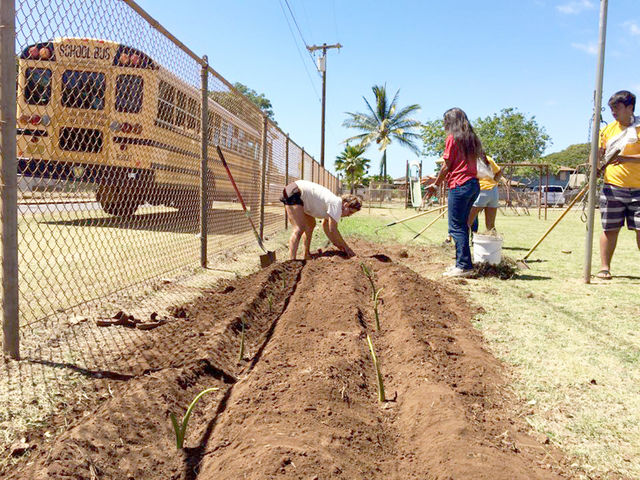Some parents on Kauai have to decide between sending their children to a school where they know they will be fed lunch or sending them to a school that will teach them Hawaiian culture. “The DOE schools have Hawaiian history
Some parents on Kauai have to decide between sending their children to a school where they know they will be fed lunch or sending them to a school that will teach them Hawaiian culture.
“The DOE schools have Hawaiian history and culture programs, but that’s not their focus,” said Keone Kealoha, executive director of Malama Kauai. “And about 100 percent of the students at Hawaiian-focused schools qualify for free lunches, but the schools don’t have the capacity internally to apply for the national lunch program.”
Because the public schools are part of the Hawaii State Department of Education, school lunches are provided through the national school lunch program. But that program is only offered at public sector, and some schools, like Hawaiian-focused charter schools, are running without one.
For parents, that means making the decision between making sure their children are nourished — physically or culturally.
Kealoha wants to give parents and their children the option of an education based on Hawaiian culture, without the worry of being fed.
“That shouldn’t be a choice parents have to make,” Kealoha said.
As a way to make that decision easier, Malama Kauai is working with Hawaiian-focused charter schools on Kauai by giving them the tools to provide its students with lunch.
With the help from Malama Kauai, three of the four Hawaiian-focused schools — Kanuikapono Learning Center, Kawakikini and Ke Kula Niihau o Kekaha Learning Center and Laboratory — have installed school gardens, in which students grow and cultivate various fruits and vegetables, which is then prepared in the cafeteria.
As a result of the program, which has been going on since 2010, a greenhouse, as well as a garden that boasts several hundred beds of taro, have been built on the campus of Ke Kula Niihau o Kekaha Learning Center and Laboratory, in Kekaha.
Eventually, the school hopes to grow fruit-bearing trees and more plots, specifically for different grades to tend.
Kawaikini, in Lihue, has also benefited from Malama Kauai’s efforts. In November, Sarah Hopps, youth and food coordinator for Malama Kauai, helped the school grow a quarter-acre garden, filled tomatoes, peppers, and native Hawaiian vegetables like uala, ipu and taro.
Kawaikini’s grounds also boast an orchard filled with apple and citrus trees.
It’s important for the students to learn values that come with gardening, Hopps said.
“It teaches caring of others and of the land,” she said.
Originally from Massachusetts, Hopps said the most rewarding part of the program is learning from the kids.
“They teach me about their culture — there’s nothing like learning from kids,” she said.
Malama Kauai is focusing on the Hawaiian-focused charter schools because their students need it the most, Kealoha said.
“We want to serve more of the at risk communities; they are probably some of the more socially and economically disadvantaged pocket of the island,” he said.
Giving the children a chance to grow and cultivate their own food is important because it connects them with the Hawaiian culture, Kealoha said.
“It’s much deeper than just eating lunch, it’s about keeping the culture,” he said. “If we don’t figure out a strategy to keep children engaged in their culture, we may not have those resources in the future.”
As the children grow the food in the gardens, they also learn the stories behind them, Kealoha said.
For example, Hawaiians traditionally used specific taro to attract olepu. Once the fish is caught, it is prepared with that taro, Kealoha said.
“If we don’t pass on that knowledge, it just gets lost,” he sad.
While the focus is on the Hawaiian-focused charter schools, Malama Kauai, through The Kauai School Garden Network, also helps all schools to revamp or install gardens on their campuses.
The Kauai School Garden Network was established in 2010. It has helped establish over 30 gardens on pre-kindergarten through 12th-grade campuses islandwide, Kealoha said.
Additionally, in 2014, the organization developed Village Harvest, which delivers food to the Hawaiian-focused charter schools and Boys and Girls Clubs on the island.
In the last two years, the program has given over 12,000 pounds of fresh food to students.
Kealoha hopes the programs will allow schools to be self-reliant.
“We work to bring infrastructure and provide knowledge, but we would like the school to be able to handlen it,” he said. “But our preferred reality is that the kids and their parents don’t have to make the choice between eating and culture.”


